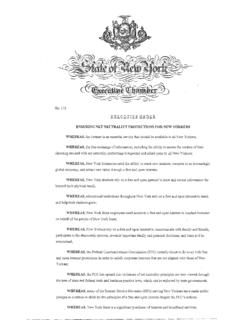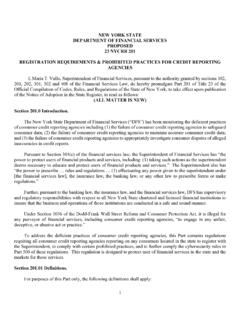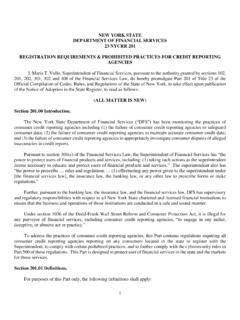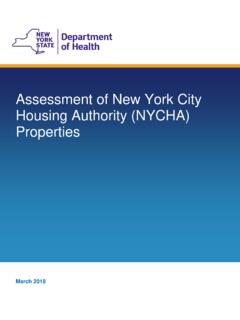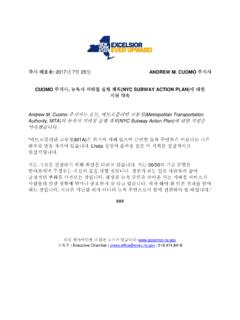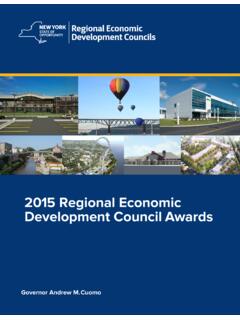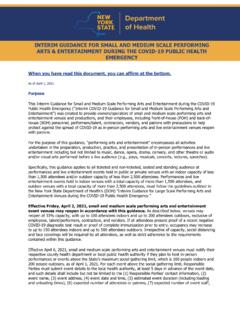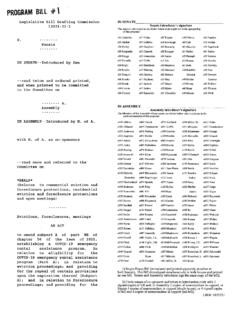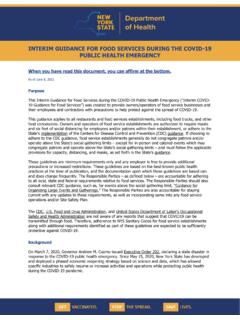Transcription of Reopening New York - Government of New York
1 As of April 6, 2021. Reopening New york These guidelines apply to all religious and funeral gatherings, including burial and Guidelines for religious and committal services , statewide. For full details, see Interim COVID-19 Guidance for religious and funeral services and Operations of Faith-Based Institutions.. funeral services During the COVID-19 public health emergency, all operators of religious and funeral services should stay up to date with any changes to state and federal requirements related to religious and funeral services and incorporate those changes into their operations. This guidance is not intended to replace any existing applicable local, state, and federal laws, regulations, and standards. Mandatory Recommended Best Practices Physical For any religious or funeral service, limit the Limit in-person presence of staff to only those congregant/attendee capacity to no more than 50% of employees/volunteers necessary.
2 Distancing the maximum occupancy for a particular area as set by the certificate of occupancy for services occurring Modify the use and/or restrict the number of stations indoors. Such indoor capacity shall be updated as the ( podiums) and seating areas, so that staff members, public health conditions change and remain consistent volunteers, and attendees are at least 6 ft. apart in all with the occupancy limits for similar industries. directions and are not sharing stations or seats without cleaning and disinfection between use, unless all Limit outdoor capacity such that at least 6 ft. can be individuals are members of the same household. maintained among individuals, except members of the same household. Implement a property-specific Hold services outdoors ( services for religious capacity limit for outdoor areas to ensure that the gatherings, graveside-only funerals) and/or provide number of congregants/attendees on the premises at remote service options ( live streaming, AM/FM.)
3 Any given time doesn't jeopardize the ability of broadcast), when possible. employees/volunteers to enforce, and congregants/. attendees to comply with, public health requirements. Offer advanced sign-ups to manage capacity. A distance of at least 6 ft. must be maintained amongst Change or remove practices that involve close contact or all individuals at all times, unless safety or the core sharing things among members of different households activity requires a shorter distance ( pallbearing) or ( sharing a car or limousine ride between locations, the individuals are members of the same household. providing food/beverages for attendees before, during, or However, any singing activity must provide for a after the event or service). distance between individuals of 12 ft.
4 , subject to additional protective measures. Hold drive-in services . Ensure attendees remain in the Employees, volunteers, and/or attendees should wear vehicle in which they arrived and that they don't interact acceptable face coverings at all times. However, any physically with clergy, employees, or attendees in other time employees, volunteers, and/or attendees must vehicles; vehicles should contain only members of a single come within 6 ft. of one another (or 12 ft., if singing), household, and cars must be at least 6 ft. apart or use they must wear face coverings, unless they are alternate parking spaces. members of the same household. Reduce bi-directional foot traffic by posting signs with Prohibit the use of small spaces ( elevators, vehicles) arrows in narrow aisles, hallways, or pews.
5 By more than one individual at time, unless all individuals are wearing face coverings. If occupied by more than one person, keep occupancy under 50% of maximum capacity. Prohibit holding or shaking hands of members in different households during services or prayers. Limit activities involving singing ( choir, soloist, cantor, musical ensemble), unless 12 ft. of separation can be provided between individuals or additional distancing or physical barriers can reduce transmission of respiratory droplets. WEAR A MASK. GET TESTED. SAVE LIVES. As of April 6, 2021. Reopening New york These guidelines apply to all religious and funeral gatherings, including burial and Guidelines for religious and committal services , statewide. For full details, see Interim COVID-19 Guidance for religious and funeral services and Operations of Faith-Based Institutions.
6 funeral services During the COVID-19 public health emergency, all operators of religious and funeral services should stay up to date with any changes to state and federal requirements related to religious and funeral services and incorporate those changes into their operations. This guidance is not intended to replace any existing applicable local, state, and federal laws, regulations, and standards. Mandatory Recommended Best Practices Protective Provide workers with an acceptable face covering at no- Place donation plates/boxes in central location with cost to the worker and have an adequate supply of proper distancing protocols in place. Equipment coverings in case of replacement. Remove religious texts from pews or benches, and Acceptable face coverings include but are not limited to encourage congregation to bring their own.
7 Cloth ( homemade sewn, quick cut, bandana), surgical masks, and face shields. If choir/musical ensemble meets enhanced distancing measures, encourage members to launder their own Face coverings are required at all times except while gowns at home and bring their own instruments, where seated, provided all individuals are 6 ft. apart except for possible. immediate household members. Faith leaders, officiants, volunteers, and/or attendees must be Adapt certain religious practices that traditionally require prepared to don a face covering if another person close contact in order to minimize contact between unexpectedly comes within 6 ft. ( when walking to individuals. seats). Empty fonts or other shared water-related service or Face coverings must be cleaned or replaced after use ceremonial activities.
8 And may not be shared. Consult the CDC guidance for additional information on cloth face coverings and other types of personal protective equipment (PPE), as well as instructions on use and cleaning. If providing gowns or other garments, ensure they are cleaned and laundered between uses. Train workers on how to don, doff, clean (as applicable), and discard PPE. Limit the sharing of objects ( religious texts, collection plates) as well as the touching of shared surfaces ( pews, instruments, doors, railings); or, require individuals to wear gloves when in contact with shared objects or frequently touched surfaces; or, require individuals to sanitize or wash their hands before and after contact. WEAR A MASK. GET TESTED. SAVE LIVES. As of April 6, 2021. Reopening New york These guidelines apply to all religious and funeral gatherings, including burial and Guidelines for religious and committal services , statewide.
9 For full details, see Interim COVID-19 Guidance for religious and funeral services and Operations of Faith-Based Institutions.. funeral services During the COVID-19 public health emergency, all operators of religious and funeral services should stay up to date with any changes to state and federal requirements related to religious and funeral services and incorporate those changes into their operations. This guidance is not intended to replace any existing applicable local, state, and federal laws, regulations, and standards. Mandatory Recommended Best Practices Hygiene, Cleaning, Adhere to hygiene, cleaning, and disinfection requirements from the Centers for Disease Control and and Disinfection Prevention (CDC) and Department of Health (DOH) and maintain cleaning logs on site that document date, time, and scope of cleaning.
10 Provide and maintain hand hygiene stations on site, including handwashing with soap, water, and paper towels, as well as an alcohol-based hand sanitizer containing 60% or more alcohol for areas where handwashing is not feasible. Hand sanitizer must be placed throughout the location. Provide and encourage participants to use cleaning/disinfection supplies before and after use of shared and frequently touched surfaces, followed by hand hygiene. Ensure distancing rules are adhered to in restrooms by reducing capacity, where feasible. Regularly clean and disinfect the location or facility and conduct more frequent cleaning and disinfection for high risk areas used by many individuals ( restrooms) and for frequently touched surfaces, using Department of Environmental Conservation (DEC).
